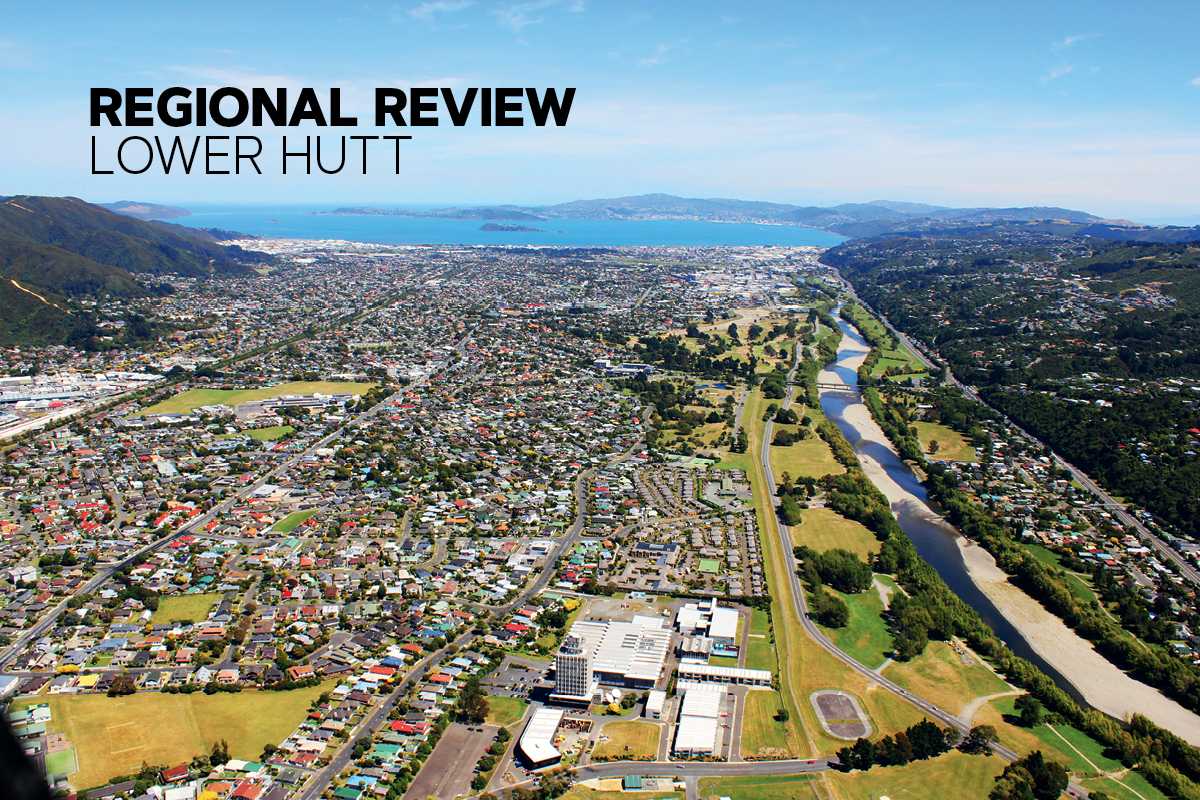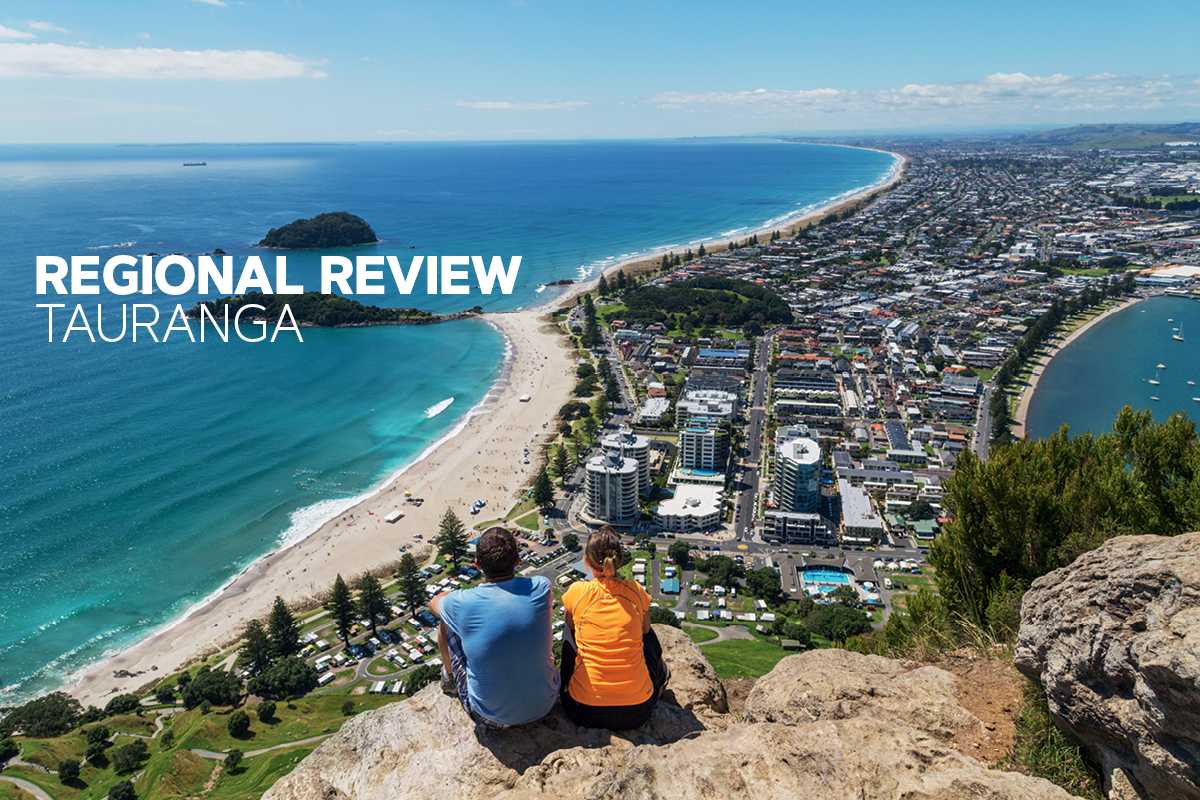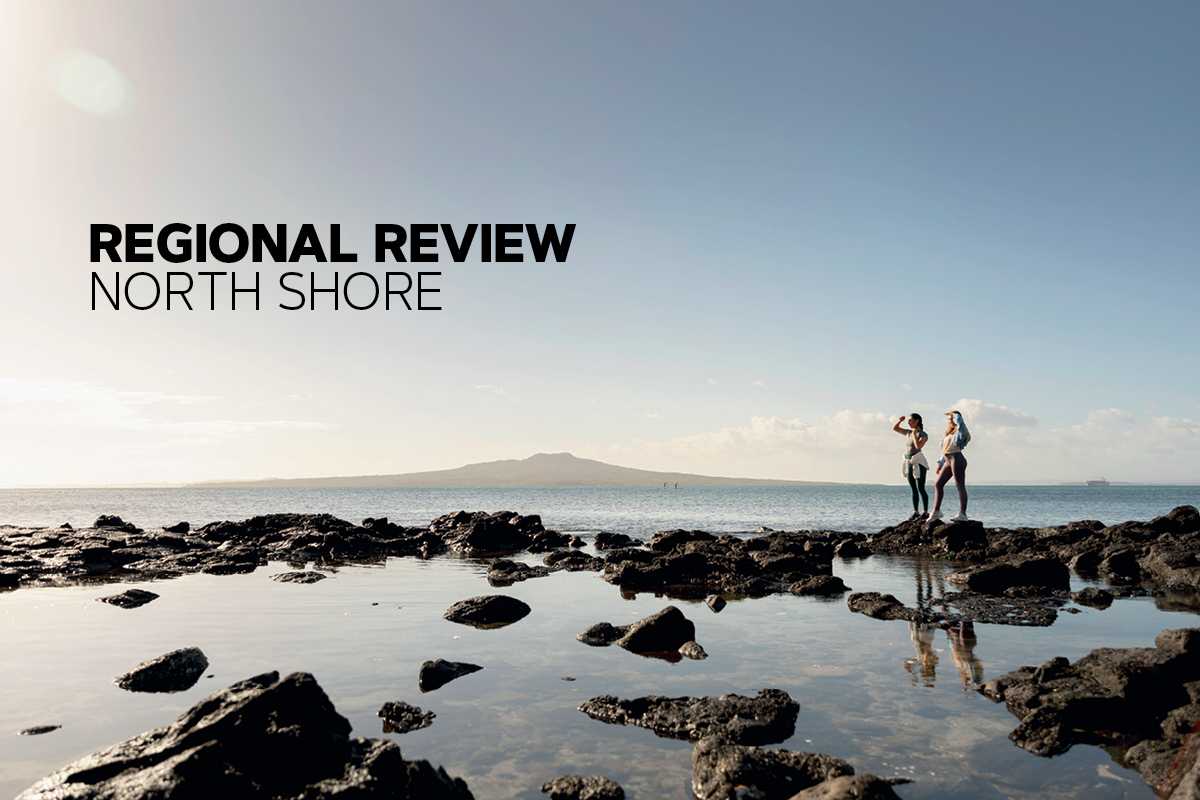
North Shore property opportunities
From the galleries of Devonport to fine dining restaurants by the sea in Takapuna, the North Shore is one of Auckland’s most desirable locations, combining well-established urban areas with pockets of native bush, golden beaches, and thriving cafe culture, Sally Lindsay writes.
9 April 2024
Auckland’s Harbour Bridge is much more than a skyline decoration, it plugs North Shore residents directly into the heart of the city.
Enjoying the many perks of North Shore living doesn’t require sacrificing access to all that Auckland’s CBD has to offer. A wealth of bus routes and easy bridge access for cars gives the best of both worlds. Ferry services from Birkenhead, Northcote Point, Beach Haven and Devonport also provide a great alternative way of commuting to and from the CBD.
It has a younger, diverse population, many of who are employed in technology. That came about in the 2010s, a period of significant change for the North Shore.
In 2015, business leaders and scholars from Albany and Massey Universities gathered at the Grow North conference. Those at the symposium committed to a vision to make North Shore a world-recognised hub for innovation by 2050.
North Shore stormed into the 2020s as one of New Zealand’s fastest-growing populations, and the blossoming of great tech jobs has attracted young, diverse residents giving the area a particular vibrance among Auckland region’s cities and suburbs.
Top North Shore Beaches
North Shore runs ahead of the pack when it comes to sandy, sunny beaches. The white sand strips at Takapuna, Milford, and Cheltenham in Devonport are just a few minutes away from most residents. Most suburbs, such as Birkenhead, have access to beaches or inner harbour water areas, with many swimming spots dotted from Northcote Point to Beach Haven wharf. This allows for numerous water activities – from boating and fishing, to paddleboarding and jet skiing.
A large urban area of Auckland, North Shore also has many top suburbs. Two of Auckland’s most sought-after suburbs are Takapuna and Devonport, known for their community feel, upmarket retail, and café scene, are about 20 minutes from the city centre.
Takapuna boasts a shopping centre and busy streets between the freshwater Lake Pupuke, the Takapuna beach reserve playground, and Takapuna beach itself. A local favourite is the historical ‘lava’ trail along its foreshore, with views across to the Rangitoto Island.
Further down the bay is Devonport, Auckland’s “Victorian lady by the sea”. With its string of 19th-century shop fronts, boutique shops, art galleries and a well-stocked library, it’s easy to while away a day in this seaside village and take the 15-minute walk up Mount Victoria for a picnic with 360-degree views of Auckland and the Waitemata Harbour.
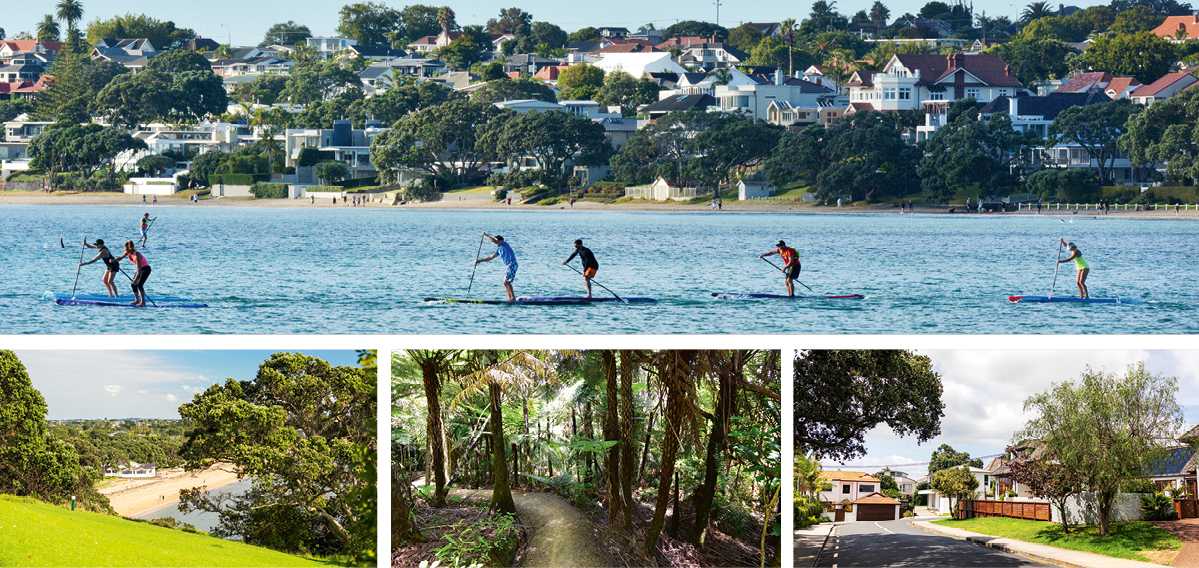
Further north and the suburb of Albany boasts Massey University. Sports fans can catch a game of rugby or soccer at the North Harbour Stadium, or have a splash at the Albany Stadium pool with climbing walls and water cannons for the kids – and a huge spa and a sauna for the grown-ups.
For those who prefer nature a bit more landlocked, there are great tramps at the Fernglen Native Plant Gardens, Kauri Park, Birkenhead Domain, and Mount Victoria, among plenty of other green spaces still practically in the Sky Tower’s shadow.
The suburbs of Rosedale and Albany present perfect options for family life. Houses are slightly more affordable in these areas compared to Devonport and Takapuna.
Auckland’s biggest real estate agency, Barfoot & Thompson, has data that shows house listings hit an 11-year peak in February. Not since 2013 has Auckland had so many residential properties available for sale, rising from 1,221 listings in January this year to the new high of 5,382 on the agency’s books.
This has not stopped North Shore house prices from rising steadily after troughing in the middle of last year. At Pinehill, house values have risen 7.2 per cent from $1,669,600 to $1,789,950, followed by Birkdale with a 4 per cent increase from $958,150 to $996,200, Glenfield rising by 2.2 per cent from $1,029,750 to $1,052,450 and Beach Haven up by 2.1 per cent from $1,072,850 to $1,095,900.
At the other end of the scale, Browns Bay has risen by just 0.7 per cent from $1,179,400 to $1,188,100 while Hillcrest is up 0.5 per cent from $1,203,650 to $1,209,700 and Northcote is steady, rising from $1,232,100 to just $1,232,150.
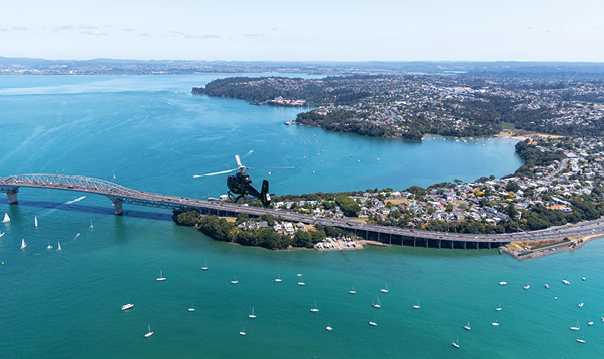
Home seller backlog
The number of properties for sale on the North Shore has definitely risen, Rob Carter, Harcourts Cooper & Co general manager says.
“The year started with a backlog of people wanting to sell. The market is not flooded but the listings are at a similar level as 2018,” he says.
Since then there has been a significant increase in housing and population. “It could be debated that the volumes could be the new norm. It is certainly providing more choice for buyers.”
Carter says astute buyers see the market as providing good opportunities to buy. “It was not long ago that buyers were yearning for the conditions we have now.”
He says while there is a degree of caution from some buyers, confidence is building. This momentum is being fuelled by downward movement in interest rates by some banks, the OCR remaining stable and government policy.
“Immigration remains high and statistics clearly showing as a country we are not building enough houses. So, while there is a good supply of new listings, that will evolve to demand exceeding supply.
Coastal, lifestyle and high-end properties are always in high demand and Carter says for other buyers, budget drives the suburbs they consider as the average price for a three-bedroom home is $1.19 million.
More available listings for high-end properties have also risen along with the rest of the market. Carter says this in itself is creating more movement among owners, but generally they have more time on their side when selling and this alleviates the pressure on price falls because there is no urgent need to sell.
“Many of the more expensive properties are sold on a confidential basis but recent sales confirm there is solid demand for exceptional homes.”
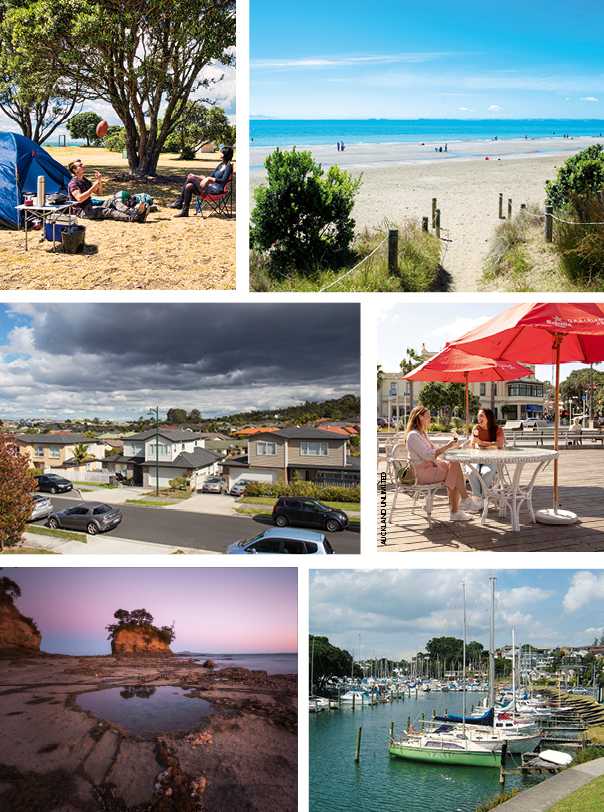
Few affordable rentals
Despite a recent flood of houses for sale, Crockers Property Management business development general manager Shanon Aitken says the North Shore is by far the most popular rental market, excluding Albany, out of the top five renter locations in Auckland.
On TradeMe it has 36.8 per cent of the watch list statistics followed by Auckland city at 28.4 per cent and Albany at 6.7 per cent.
The North Shore’s popularity means a lack of rentals across all areas, but it is particularly acute in the affordable bracket.
The North Shore is thousands of rentals short, Aitken says. “It depends on the location, as there is an overall shortage in most suburbs. Certain areas are more affected than others, such as the Bays location, for example, which is more of an owner-occupied area.”
Crockers, like other agencies, gets a huge response from prospective renters turning up at viewings for properties that are well presented. “We have been seeing properties rented at the first viewing with multiple applicants.”
He says about 15-20 groups are turning up at listing viewings, particularly in sought after school zones for West Lake and Rangitoto. “The desirable property types will receive even more enquiry than this,” Aitken says.
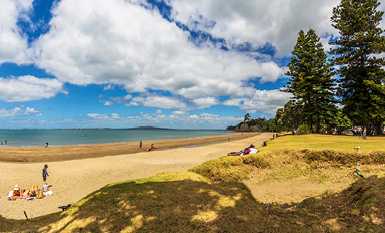
Rental market fluctuations are few and far between, but Aitken says rents have increased rapidly over the past two years.
Families will always look at three-bedroom stand-alone houses and couples two-bedroom properties. Rentals are sitting on Trade Me for just 11 days, down 27 per cent on the same time last year.
Trade Me’s data shows across the North Shore the average rent for a two-bedroom property is $600, which is up 5 per cent on the same time last year, while new rental listings are up 14 per cent.
Crockers data show rents two-bedroom properties have increased from -2 per cent to 13 per cent over the past year. For three-bedroom houses rents have risen from 7 to 15 per cent. See charts below.
While Crockers is still attracting new listings for its property management book, they are mostly from people who are moving out of the area but have decided not to sell their house in the existing market. “We are also still getting a few from developments that were sold down a few years ago and coming to completion,” Aitken says.
Investors have been sitting on the side lines – either those who are existing investors increasing their portfolios or others starting an investment portfolio. He says any new investors are mostly people who are already property owners turning to investment because they have struggled to sell their houses at levels they are prepared to let them go at.
“High interest rates are keeping genuine investors out of the market. Those rates combined with high property prices are making investments uneconomic even with the recent rent increases.”
And high interest rates are the main issue facing landlords. “Rents haven’t kept pace with the increased costs making it uneconomical to invest in rental properties in certain areas,” he says.
On the upside, compliance issues for landlords are not the bugbear compared to what they have been in the past.

Corelogic North Shore
Kelvin Davidson, Chief Property Economist
The data
Rental data is sourced from the Ministry of Business, Innovation and Employment based on rental bonds lodged. This data is supplied grouped into geographic areas based on statistical area units used by Statistics NZ for the census and as a result do not always match well with common usage suburb names.
The rental data for each area is matched to property price information from our database to determine property prices and therefore yield. The yield is calculated as the annualised rental income divided by the median property value calculated using our E-Valuer.
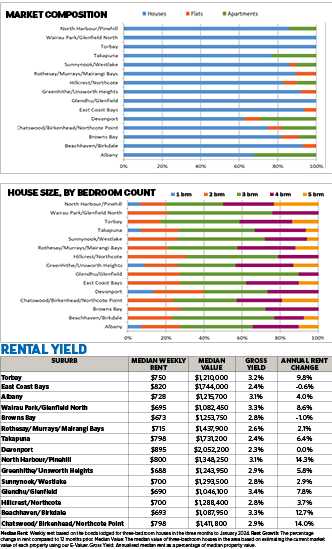
North Shore rentals
The rental market across North Shore is dominated by houses. Of the 1,491 properties recently available for rent, 1,272 have been houses (85 per cent), with 156 apartments (11 per cent) and 63 flats (4 per cent).
The largest markets for flats have been Rothesay/Murrays/Mairangi Bays (12) and Hillcrest/Northcote (9), with many other suburbs having smaller numbers. For apartments, most have been in Albany (42) and Takapuna (27), although Devonport is also up there in terms of apartments as a share of all properties recently available for rent (29 per cent).
There’s been a solid spread of houses recently for rent right across North Shore, with most in Sunnynook/Westlake (150), although at least 80 in areas such as Torbay, Wairau Park/Glenfield North, North Harbour/Pinehill, East Coast Bays, and Glendhu/Glenfield.
Rental property by size
Looking at the 1,272 houses recently for rent across North Shore, there have been relatively few in the one and five-bedroom brackets, at 30 (2 per cent) and 105 (8 per cent) respectively. Browns Bay doesn’t feature in either of those categories, while Greenhithe/Unsworth Heights is represented in both bedroom brackets.
There have been similar numbers of two and four-bedroom houses available for rent across North Shore, at 291 (23 per cent) and 306 respectively (24 per cent). The most two-bedroom houses have been in Sunnynook/Westlake (39) and Hillcrest/Northcote (30), while Sunnynook/Westlake (33) and Rothesay/Murrays/Mairangi Bays (30) had the most with four bedrooms.
For three-bedroom properties – 540 (or 43 per cent of all houses recently available for rent) – Sunnynook/Westlake (69) was a large market, as well as Glendhu/Glenfield (54). In terms of three-bedroom properties as a proportion of all houses recently for rent, an area such as Beachhaven/Birkdale has had quite a high figure (54 per cent), but Chatswood/Birkenhead/Northcote Point is lower (33 per cent).
Rent And Yield
Median weekly rents for three-bedroom houses in North Shore range from $673 in Browns Bay to $895 in Devonport. Median values start at $1,046,100 in Glendhu/Glenfield and rise to $2,052,200 in Devonport. Gross rental yields are low across North Shore, with the highest for three-bedroom houses 3.4 per cent in Glendhu/Glenfield. The lowest sits at 2.3 per cent in Devonport. East Coast Bays and Takapuna are close to that mark, at 2.4 per cent. Rents have shown gains in parts of North Shore lately, with rises for three-bedroom houses of 10 per cent or more in Torbay, North Harbour/Pinehill. Rents have been flat or down in Devonport, East Coast Bays and Browns Bay.
